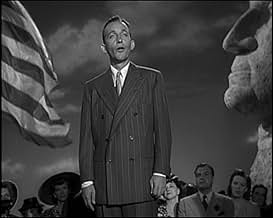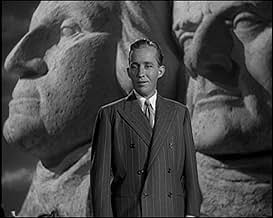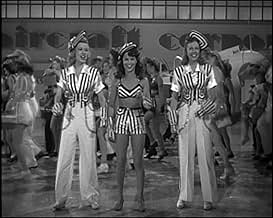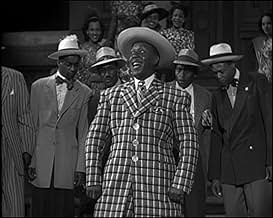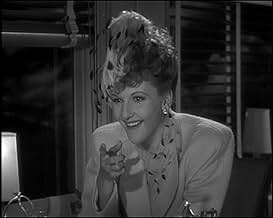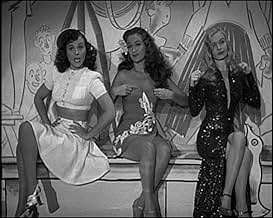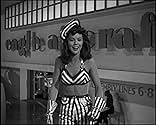VALUTAZIONE IMDb
6,5/10
709
LA TUA VALUTAZIONE
Aggiungi una trama nella tua linguaA Paramount Studios security guard who was a major actor during the silent film era must carry out the illusion that he is still a big deal when his sailor son comes to visit.A Paramount Studios security guard who was a major actor during the silent film era must carry out the illusion that he is still a big deal when his sailor son comes to visit.A Paramount Studios security guard who was a major actor during the silent film era must carry out the illusion that he is still a big deal when his sailor son comes to visit.
- Regia
- Sceneggiatura
- Star
- Candidato a 2 Oscar
- 1 vittoria e 2 candidature totali
Recensioni in evidenza
In the 1930s and 40s, most of the major studios made films that featured a variety show, of sorts, with the contract stars. MGM struck gold with this in the early sound film "The Hollywood Review of 1929" and this film set the stage for quite a few followup films. This sort of film became especially popular during WWII, as these films were often sent overseas to entertain the troops--such as "Hollywood Canteen" and "Star Spangled Rhythm". "Star Spangled Rhythm" is a tad different in that there is more plot than many of these films. In other words, it's not just a variety show and this really doesn't begin until the film is at the half-way point.
The film begins as a sailor (Eddie Bracken) convinces a group of his friends on shore leave to come with him to Paramount Studios, as his father is head of production! However, his dad (Victor Moore) is NOT the boss but a lowly security guard on the lot. Now wanting to get caught, Moore and Betty Hutton (who plays Bracken's VERY energetic girlfriend) work together to convince the sailors (and a Marine they picked up along the way) that Moore indeed is the big kahuna! For me, this is the best part of the film, as the plot is pretty cute and gets funny when the real head of production walks into the middle of this--and thinks he's been replaced! Unfortunately for Moore, the boss finally does realize what's been happening and it looks as if the plan is about to fall apart. However, through some further finagling, Moore and Hutton are able to arrange a show for the servicemen to convince the fellas that nothing is up....that Moore IS a big-shot.
As far as the variety show goes, there are no major surprises but it's nice to see the actors and actresses play themselves in a series of nice cameos. What I actually struck me most about this was how incredibly short Dorothy Lamour, Veronica Lake (I did know she was 'diminutive') and Paulette Goddard were, as they were towered over by the other actresses in the first scene of the variety show. Not surprisingly, the three later sang a number together. In addition to these women, Bob Hope, Bing Crosby, Ray Milland, Franchot Tone, Fred MacMurray and many others were on hand for the show.
In addition to the show, you also get to see some stars walking around the studio lot. A few of these cameos are bizarre--and wonderful for cinephiles like myself. You get a rare role for Cecil B. DeMille and Preston Sturgis as themselves. Plus, in addition to seeing Bing Crosby walking about the lot, his son Gary is with him. I liked this very contrived "behind the scenes" look of the film. Sure, you know this is all for a fictional film, but it's pretty cool if you're into old films like me.
Overall, while not all the variety acts work well, many do. Plus the story that ties them all together is very good. The film may bore some (especially those who know nothing of the classic era in Hollywood), but is a treat for any 1940s film buff.
By the way, although the show is supposed to be done on stage live in front of the sailors, it's very, very obvious many of the acts were performed on a sound stage--with sound stage sets. Just suspend your sense of disbelief at these moments or they might just make your brain hurt! After all, the shower scene is obviously NOT done in front of the men but it is quite funny!
The film begins as a sailor (Eddie Bracken) convinces a group of his friends on shore leave to come with him to Paramount Studios, as his father is head of production! However, his dad (Victor Moore) is NOT the boss but a lowly security guard on the lot. Now wanting to get caught, Moore and Betty Hutton (who plays Bracken's VERY energetic girlfriend) work together to convince the sailors (and a Marine they picked up along the way) that Moore indeed is the big kahuna! For me, this is the best part of the film, as the plot is pretty cute and gets funny when the real head of production walks into the middle of this--and thinks he's been replaced! Unfortunately for Moore, the boss finally does realize what's been happening and it looks as if the plan is about to fall apart. However, through some further finagling, Moore and Hutton are able to arrange a show for the servicemen to convince the fellas that nothing is up....that Moore IS a big-shot.
As far as the variety show goes, there are no major surprises but it's nice to see the actors and actresses play themselves in a series of nice cameos. What I actually struck me most about this was how incredibly short Dorothy Lamour, Veronica Lake (I did know she was 'diminutive') and Paulette Goddard were, as they were towered over by the other actresses in the first scene of the variety show. Not surprisingly, the three later sang a number together. In addition to these women, Bob Hope, Bing Crosby, Ray Milland, Franchot Tone, Fred MacMurray and many others were on hand for the show.
In addition to the show, you also get to see some stars walking around the studio lot. A few of these cameos are bizarre--and wonderful for cinephiles like myself. You get a rare role for Cecil B. DeMille and Preston Sturgis as themselves. Plus, in addition to seeing Bing Crosby walking about the lot, his son Gary is with him. I liked this very contrived "behind the scenes" look of the film. Sure, you know this is all for a fictional film, but it's pretty cool if you're into old films like me.
Overall, while not all the variety acts work well, many do. Plus the story that ties them all together is very good. The film may bore some (especially those who know nothing of the classic era in Hollywood), but is a treat for any 1940s film buff.
By the way, although the show is supposed to be done on stage live in front of the sailors, it's very, very obvious many of the acts were performed on a sound stage--with sound stage sets. Just suspend your sense of disbelief at these moments or they might just make your brain hurt! After all, the shower scene is obviously NOT done in front of the men but it is quite funny!
A security guard (Victor Moore) has been telling his son (Eddie Bracken) in letters that he's the head of Paramount. Now the son is home on shore leave from the Navy and the dad wants to keep him from finding out the truth. So he gets help from a studio switchboard operator (Betty Hutton) who is in love with his son. Together they hatch a plan to have the father impersonate the studio head during the son's visit.
Most of the studios during WW2 made one of these all-star films, usually with a flimsy plot and lots of musical numbers. They're all great fun and this is one of the best. Betty Hutton is just the most adorable person ever. I could watch her read the phone book for an entire movie. Eddie Bracken and Victor Moore are wonderful, too. The real treat with this, and other films like it, is for classic film fans to eat up all of the movie star comedy and musical numbers. The stars include Bob Hope, Bing Crosby, Ray Milland, Veronica Lake, Paulette Goddard, Fred MacMurray, Dorothy Lamour, Dick Powell, Cecil B. Demille, Alan Ladd, and many more. Oh, and she's not the biggest star in this one, but wait 'til you get a load of Dona Drake! Hubba hubba! Have mercy! Makes me wish I had a time machine. This movie's just sheer fun from start to finish. If this doesn't make you smile, you're dead inside!
Most of the studios during WW2 made one of these all-star films, usually with a flimsy plot and lots of musical numbers. They're all great fun and this is one of the best. Betty Hutton is just the most adorable person ever. I could watch her read the phone book for an entire movie. Eddie Bracken and Victor Moore are wonderful, too. The real treat with this, and other films like it, is for classic film fans to eat up all of the movie star comedy and musical numbers. The stars include Bob Hope, Bing Crosby, Ray Milland, Veronica Lake, Paulette Goddard, Fred MacMurray, Dorothy Lamour, Dick Powell, Cecil B. Demille, Alan Ladd, and many more. Oh, and she's not the biggest star in this one, but wait 'til you get a load of Dona Drake! Hubba hubba! Have mercy! Makes me wish I had a time machine. This movie's just sheer fun from start to finish. If this doesn't make you smile, you're dead inside!
A potpourri of star turns lift the charming but silly plot above itself. Worth seeing for the Dick Powell/Mary Martin number alone. I kept backing the tape up and watching this part again and again. Why Martin wasn't a greater Hollywood star is a mystery to me, but H'wood's loss was B'way's gain. Many other nice things to see, but I have a feeling some numbers were cut from the final print. Wonder what they were?
Betty Hutton, one of the nominal stars of Star Spangled Rhythm, was not just doing it for defense as in her number, but the whole studio was doing this All Star flag waver for the defense of the morale of the USA.
I can never resist one of these all star spectaculars and there's only one I would ever have given a bad review to, and this isn't the one. Everybody working on the Paramount lot got to do his bit for defense in this film, some bits being longer than others.
The nominal plot of this film has Betty Hutton as a switchboard girl at Paramount studios and Victor Moore, a former silent western star, now working as a security guard at the studio trying to convince Eddie Bracken and a bunch of his sailor buddies that Moore is really the head of the studio. For that they have to con and bamboozle Walter Abel who is a real studio executive out of his office and off the lot so they can do their masquerade uninterrupted.
Of course Bracken asks the inevitable, pop can you get all these stars down for a big Navy show, and the con has to continue. But all of this nonsense is just an excuse for some musical and comedy numbers by the Paramount players.
Harold Arlen and Johnny Mercer wrote the score and out of it came two really big standards, That Old Black Magic which was nominated for Best Song that year, but lost to another Paramount film song, White Christmas and Hit the Road to Dreamland.
The latter was done as director Preston Sturges was playing himself and screening a musical number from his latest film. As the projector rolls on screen it's Dick Powell and Mary Martin on a Pullman car singing about finally hitting the hay after some romance. The scene is so well done I wish it was included as an integral part of a real film.
That Old Black Magic is sung by Johnny Johnson and danced by ballet star Vera Zorina. It was enormous hit that year, recorded by a flock of singers. Oddly enough not by Bing Crosby though he got to sing it in another film, Here Come the Waves.
Of course the finale is a wartime flag waving number with Bing Crosby singing Old Glory about the flag and the wonders of the country behind it. The number about the flag probably wouldn't fly today still and that's a pity.
It's even more of a pity that these musical extravaganzas are a thing of the past with the decline of the Hollywood studio system. Star Spangled Rhythm is one of the best of its kind.
I can never resist one of these all star spectaculars and there's only one I would ever have given a bad review to, and this isn't the one. Everybody working on the Paramount lot got to do his bit for defense in this film, some bits being longer than others.
The nominal plot of this film has Betty Hutton as a switchboard girl at Paramount studios and Victor Moore, a former silent western star, now working as a security guard at the studio trying to convince Eddie Bracken and a bunch of his sailor buddies that Moore is really the head of the studio. For that they have to con and bamboozle Walter Abel who is a real studio executive out of his office and off the lot so they can do their masquerade uninterrupted.
Of course Bracken asks the inevitable, pop can you get all these stars down for a big Navy show, and the con has to continue. But all of this nonsense is just an excuse for some musical and comedy numbers by the Paramount players.
Harold Arlen and Johnny Mercer wrote the score and out of it came two really big standards, That Old Black Magic which was nominated for Best Song that year, but lost to another Paramount film song, White Christmas and Hit the Road to Dreamland.
The latter was done as director Preston Sturges was playing himself and screening a musical number from his latest film. As the projector rolls on screen it's Dick Powell and Mary Martin on a Pullman car singing about finally hitting the hay after some romance. The scene is so well done I wish it was included as an integral part of a real film.
That Old Black Magic is sung by Johnny Johnson and danced by ballet star Vera Zorina. It was enormous hit that year, recorded by a flock of singers. Oddly enough not by Bing Crosby though he got to sing it in another film, Here Come the Waves.
Of course the finale is a wartime flag waving number with Bing Crosby singing Old Glory about the flag and the wonders of the country behind it. The number about the flag probably wouldn't fly today still and that's a pity.
It's even more of a pity that these musical extravaganzas are a thing of the past with the decline of the Hollywood studio system. Star Spangled Rhythm is one of the best of its kind.
Pretty much this is Paramount's contribution to the war effort in 1942. Plot basically sees Victor Moore as Pop, who by way of some deceit has to keep up the pretence to his sailor son Johnny Webster (Eddie Bracken) that he is head of the studio, when in fact he is just a gatekeeper there. As Johnny and his sailor pals make their way to the studio, Pop, aided by switchboard operator Polly Judson (Betty Hutton), sets about putting on a all star show for the boys. Cue sketches and variety turns by a ream of Paramount performers. Some of the situ comedy works, such as Bob Hope in the shower with William Bendix and Hutton trying to scale a wall aided by two bendy blokes, other moments, however, fall a little flat. But when the froth is war-oriented or the stars are poking fun at themselves, it scores well and the musical numbers are never less than pleasant.
Good old time cinema while it's also fun to play spot the star. 7/10
Good old time cinema while it's also fun to play spot the star. 7/10
Lo sapevi?
- QuizVeronica Lake's singing voice was dubbed by Martha Mears.
- BlooperDuring the jeep ride, one of the sailors is thrown out when the vehicle hits a bump and jumps onto a dirt road. The sailor is then shown back in the jeep in the next shot.
- Citazioni
[In front of Old Glory and a plaster Mt. Rushmore]
Bing Crosby: [singing] Germans, Italians, and Japs / Can't kick us off our Rand-McNally maps.
- ConnessioniFeatured in Paramount Presents (1974)
- Colonne sonoreThat Old Black Magic
Music by Harold Arlen
Lyrics by Johnny Mercer
Sung by Johnny Johnston
Danced by Vera Zorina
I più visti
Accedi per valutare e creare un elenco di titoli salvati per ottenere consigli personalizzati
- How long is Star Spangled Rhythm?Powered by Alexa
Dettagli
Botteghino
- Lordo Stati Uniti e Canada
- 602.500 USD
- Tempo di esecuzione1 ora 39 minuti
- Colore
- Proporzioni
- 1.37 : 1
Contribuisci a questa pagina
Suggerisci una modifica o aggiungi i contenuti mancanti

Divario superiore
By what name was Signorine, non guardate i marinai (1942) officially released in Canada in English?
Rispondi

